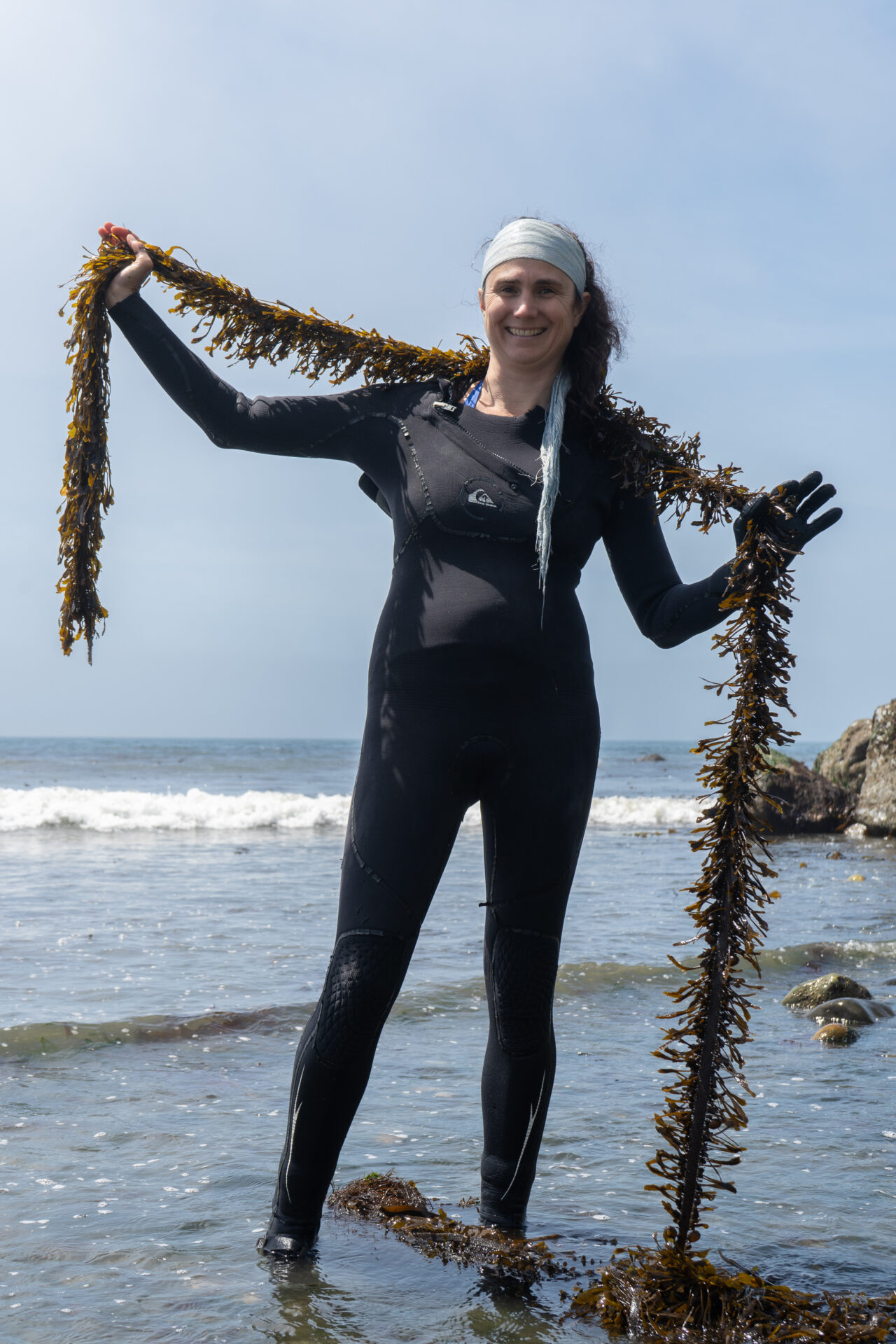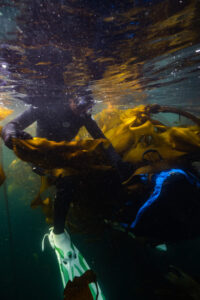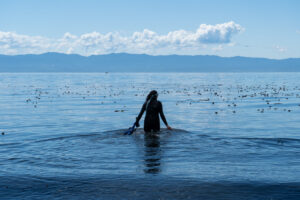Amanda Swinimer, aka “The Mermaid of the Pacific,” lives on idyllic grounds in a village west of Sooke. It’s the kind of place where people have stands along the road selling free-range eggs and where silvery, driftwood logs have metamorphosed into tall, vertical fences.
From her home and seaweed business premises, a verdant grassy field flanked by forests leads to Juan de Fuca Strait, where Amanda sustainably forages for a variety of seaweeds. “I take my wheelbarrow down to the water and collect seaweed when it’s in season,” she told me. “I cut it in the shallow waters or find it on the beach.”
Amanda, a lithe 49, had put out three scallop-shaped dishes with dulce, bull kelp and winged kelp pieces for me to enjoy. I bit into the briny bits. Although every seaweed tastes somewhat different, it was delightful to eat each one in its natural, dried form, and I devoured every last bite.
The taste reminded me of Amanda’s description of her first bite of seaweed in her book, The Science and Spirit of Seaweed: “I took a piece of dried bull kelp out of the bag, the briny smell of the sea entering my nose. I took a taste. An explosion of flavour occurred on the tip of my tongue. Salty and tingling, and with a flavour different from anything I had tasted before, a taste so powerful it seemed to crack open an untouched place inside me, where it imparted an ancient wisdom.”
Amanda grew up in Orillia, Ontario, a small town made famous by humourist Stephen Leacock and singer Gordon Lightfoot, who both hailed from there. “It’s pink granite country,” she said, “scoured out by glaciers.” But she spent family holidays on the Atlantic where she delighted in spotting the creatures hiding under rocks she upturned. “As a child, I absolutely loved dolphins,” she recalled. “I even had a rubber dolphin in the bathtub.”
Her interest in aquatic critters may have led her to earn her bachelor’s degree in marine biology at Halifax’s Dalhousie University. She spent a semester in Kenya and fondly recalls her dives in the Indian Ocean. She volunteered for a stint observing Bigg’s orcas rubbing on the beaches in the Salish Sea’s Robson Bight and grew concerned about the boats carelessly chasing the whales. She travelled in Central America, worked with dolphins in Florida and lived on a sailboat for two years in the Sooke area. For eight summers, she planted trees to support her studies and travels. And, over the last two decades, she has raised two daughters, Mahina and Nesika.
The seaweed’s taste revelation occurred when she’d ferried to Sidney Island for a job a seaweed harvester had advertised. Alas, she learned the position was filled after she’d trudged to the end of the island. To compensate for her long trek, the harvester handed her a bag of dried kelp strips. It’s that seemingly small event that led Amanda to exhaustively study books on seaweed and to complete a semester at UBC on the physiology of algae. “The professor was quite inspirational,” she recalls. “I kept asking, though, ‘is it edible?’”
Since founding her seaweed business, Dakini Tidal Wilds, in the early 2000s, Amanda has remained focused on providing “…customers with the highest quality seaweeds, hand-harvested on the rugged west coast of Vancouver Island…Tidal Wilds’ seaweeds are harvested sustainably with love and reverence for the local environment.”
No one can just harvest seaweed as a commercial enterprise. Amanda obtained a license for marine seafood processing, which must be renewed annually. She also acquired a local business license and got permission to harvest from local First Nations. “There are few regulations for farming seaweed,” she explained, “but for wild harvesting, the regulations are pretty stringent and are different for different species. Cutting must be done by hand and must leave enough growth material so the seaweed can regenerate. This makes for a sustainable harvesting system.”
Her seaweed collecting is seasonal and runs from April to September, when the algae grow actively. Always aware of tide levels, she collects from the beach and carefully washes the ocean’s gifts in the shallow waters. When cutting live seaweed, she stands chest deep in the water or dives—ensconced in a wetsuit, of course, as the water rarely rises above 10℃. She places her yield in mesh bags and then wheels it up to her double-car garage, which serves as her drying shed. The garage door has been emblazoned with bold-coloured swirly designs. To hang and desiccate the alaria (winged kelp) fronds, the feather boa and the lengthy bull kelp blades, she has installed cedar beams across the space and hammered in fat nails to hold the bounty. Seaweed cutting, weighing and packaging takes place in the garage’s alcove.
Seaweed has long been valued for its many uses. It’s been especially studied in Japan and Korea. Indigenous people used bull kelp stipes (stems) for fishing and anchor lines, the blades for basket making and the floats as eulachon oil flasks. Brown kelps contain alginates that are used commercially in many products. It’s a gummy substance which controls the flow of fluids and keeps the crystals in ice cream from separating, makes paint smooth and forms the culture medium in biological and genetic research.
Amanda focuses on seaweed’s extensive culinary and medicinal value. In her daily life, she incorporates seaweed in soups, stews and marinades, sprinkles it on salad and fish, or mixes it with nuts. Seaweed, she says, contains a heavy dose of minerals our body craves, including sodium, potassium, calcium and magnesium (life did, after all, emerge billions of years ago from the sea and continues to need its basic nutrients). Trace minerals like zinc, iodine, manganese and copper are also found in seaweed. She notes that studies have shown that carotenoid pigment in brown seaweed contains fucoxanthin, which may target a variety of cancer cells.
Most of her products are sold wholesale, with restaurant chefs in Victoria and Vancouver snapping up most of it. Her dried kelp packages are available online. She also markets a tea which combines winged kelp, wild spruce tips and organic mint.
Does she worry about serious commercial seaweed exploitation on the coast? Commenting on the growing popularity of seaweed, Amanda expresses concerns. “A lot of people see seaweed and only see dollar signs,” she said. “Farming seaweed may work but it must be done in the right way. We see genetic differences between Pacific kelp and that growing in the Strait of Georgia. We need to research how that affects the bottom, salmon runs and so on. Rather than going all in harvesting seaweed everywhere, we need precautionary studies.” She also mentions that bull kelp flourishes in cold water and that, as the ocean warms, we may lose it and its important carbon sequestration and oxygen production.
Amanda lectures on the qualities and specific properties of seaweed and its importance in carbon capture. She gives seminars on seaweed harvesting. She also authored a guide for early teens, The Science & Superpowers of Seaweed, which was published in May 2023. I’ve seen a copy, and it’s just the lavishly illustrated book you want to take along when you and your children or grandchildren are cruising the BC beaches.


